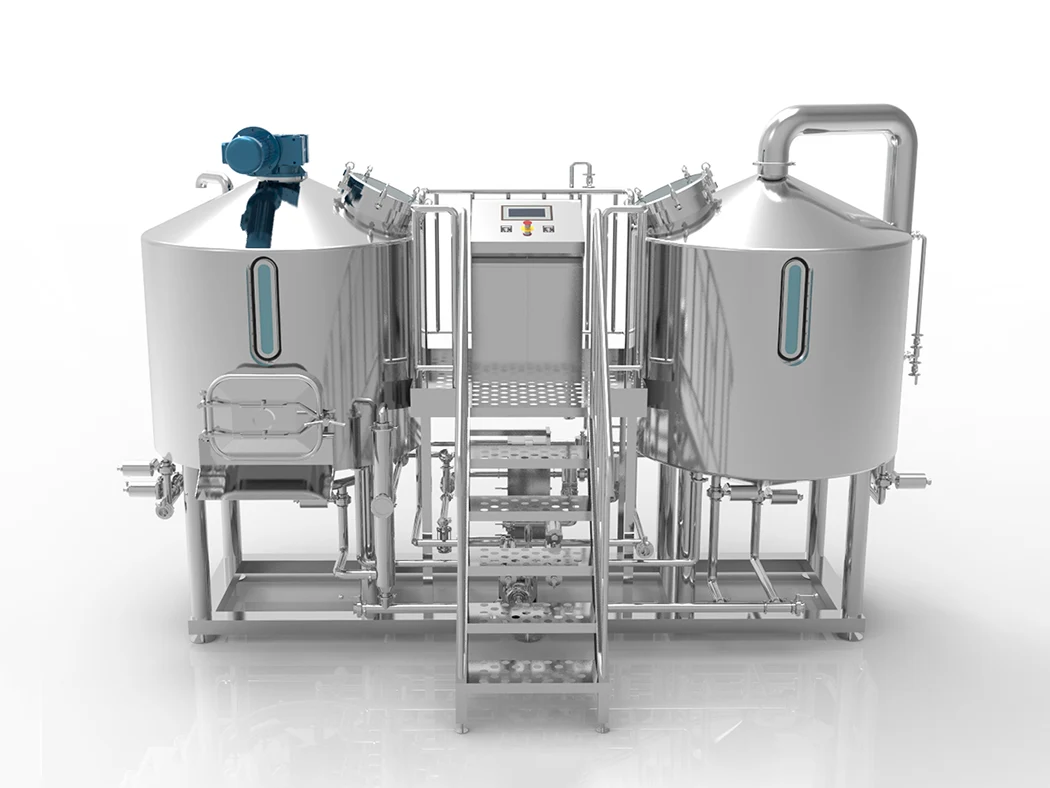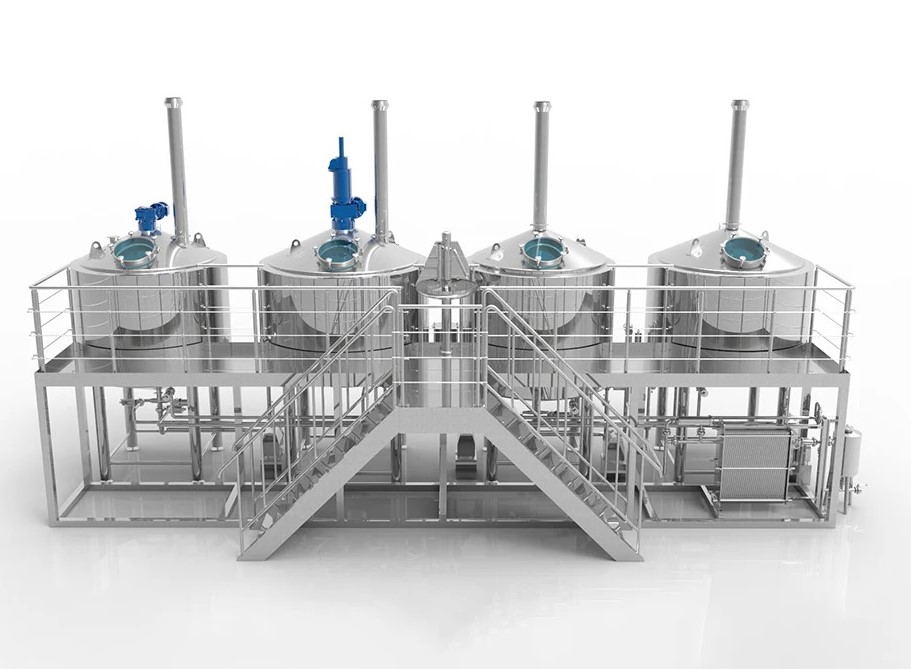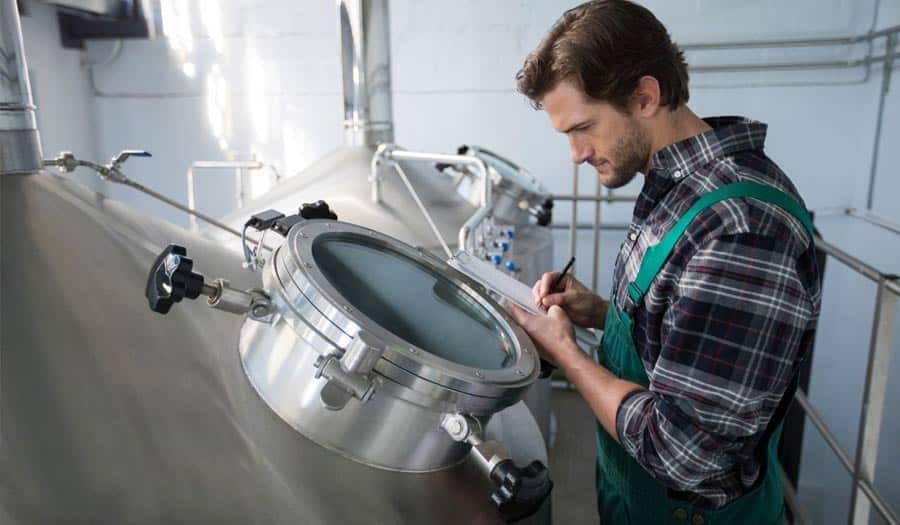With the continuous development of craft beer and modern brewing techniques, storage equipment—being the core infrastructure of a brewing facility—directly impacts production efficiency, product quality, and operational costs. Among the many storage solutions available, stainless steel tanks have become the top choice for breweries and other beverage and food processing enterprises due to their excellent hygiene performance, corrosion resistance, and mechanical strength. This article systematically analyzes, from a brewing process perspective, how to select réservoirs de stockage en acier inoxydable that best suit your production workflow, helping enterprises achieve optimal equipment configuration while ensuring production safety and product quality.
The Critical Role of Stainless Steel Tanks in the Brewing Process
Stainless steel tanks are not only used to store raw water, wort, and fermented beer, but also serve multiple purposes such as storing mash liquids, preserving yeast cultures, holding CIP cleaning solutions, and refrigerating finished products. Their hygienic properties mean the tanks must comply with food safety standards to avoid secondary contamination. Their mechanical strength ensures structural stability under varying pressure and temperature conditions. Excellent sealing performance is essential for maintaining a sterile environment during fermentation, preventing contamination by external microorganisms.
From a process standpoint, tank selection must align with specific usage stages and technical requirements. For example, fermentation tanks must support pressure regulation and temperature control; mash tanks require uniform heating and mixing capabilities; cold storage tanks need efficient insulation and cooling systems. Therefore, focusing solely on tank material is not sufficient. It is essential to consider structural design, functional configuration, and the level of automation when selecting the appropriate stainless steel tank.
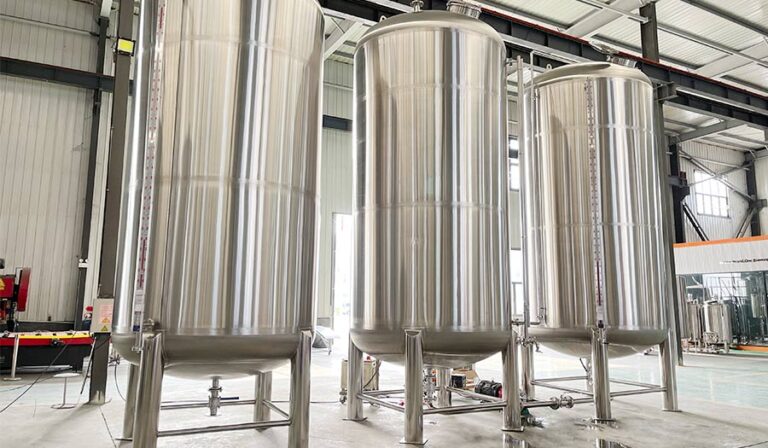
Key Considerations for Selecting Stainless Steel Storage Tanks
Material Grade and Corrosion Resistance
- 304 Stainless Steel: Contains 18% chromium and 8% nickel, offering good resistance to general acidic and alkaline environments. It is relatively cost-effective and suitable for storing most mash liquids, cooling fluids, and non-corrosive materials.
- 316L Stainless Steel: An upgraded version of 304 with added molybdenum, enhancing resistance to pitting and chloride corrosion. It is ideal for storing highly acidic substances and CIP (Clean-in-Place) cleaning solutions, making it the preferred choice for premium breweries and pharmaceutical industries.
Additionally, attention should be paid to the thickness of the steel plate and the quality of welding. Thin materials may compromise mechanical strength and sealing performance, while uneven welds or porosity can lead to leakage or contamination.
Tank Capacity and Shape Design
Tank capacity should be determined based on production scale and process requirements. Small craft breweries typically use tanks ranging from 500L to 3000L, while medium-to-large industrial breweries utilize tanks ranging from several tons to several hundred tons.
In terms of shape:
- Vertical cylindrical tanks are the most common, offering efficient space utilization and strong structural integrity.
- Conical-bottom tanks facilitate sediment discharge and yeast recovery, making them suitable for fermentation and maturation stages.
- Horizontal tanks are better suited for limited-space environments or special process requirements.
- An appropriately designed capacity and tank shape ensures smooth process integration, operational convenience, and effective cleaning.
Insulation and Cooling System Configuration
Temperature control is critical throughout the brewing process, particularly during mashing and fermentation. Heating or cooling is typically achieved through jackets or coils:
- Jacketed design: A layer around the tank wall allows hot water or coolant to circulate, providing uniform temperature control. Ideal for main fermentation tanks and mash tuns.
- Coil design: Internal stainless steel coils allow fluid to circulate for heat exchange, suited for auxiliary cooling or specialized temperature control.
Insulation layers, typically made of polyurethane or rock wool, reduce heat loss, enhance energy efficiency, and maintain fermentation stability.
Sealing Performance and Pressure Tolerance
Sealing integrity is essential to maintain a sterile environment and prevent oxygen or contaminants from entering. Basic requirements include sealed lids and sanitary-grade flange fittings.
Fermentation tanks also require pressure-resistant designs, capable of withstanding both positive and slight negative pressures. This ensures proper CO₂ release while preventing air backflow. Safety features such as pressure gauges, relief valves, and exhaust valves are indispensable.
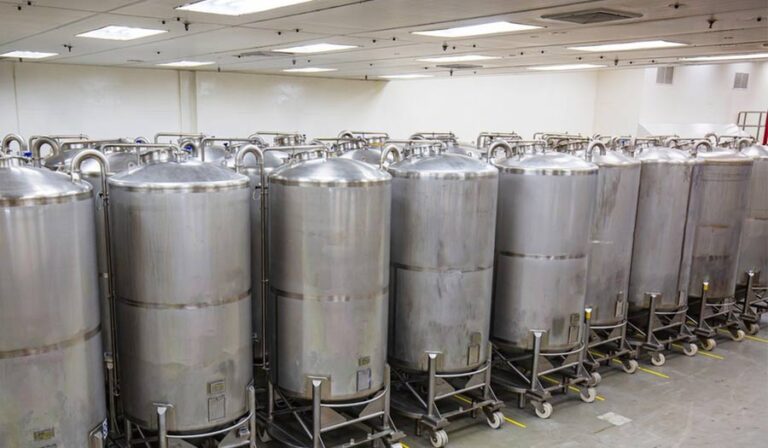
Ease of Cleaning and CIP Compatibility
Cleanliness is crucial for beer quality and hygiene. Design considerations should include:
- Smooth interior surfaces (mirror-polished),
- Flush, crevice-free welds, and
- Dead space-free construction.
Compatibility with CIP (Clean-in-Place) systems is essential. Tanks should be equipped with spray balls or spray pipes to support acid-alkali circulation cleaning, significantly reducing manual labor and improving cleaning efficiency.
Select stainless steel tank types based on the brewing process.
Raw material and wort storage tanks
These tanks are primarily used for temporary storage of brewing water and mashed wort. Temperature and pressure requirements are relatively relaxed, but the material must be hygienic and free of impurities. They are typically made of 304 stainless steel, with capacity adjusted according to production volume. The design is simple, with emphasis on tightness and easy emptying.
Cuves de fermentation
Cuves de fermentation are core equipment in breweries and require precise temperature control (jacketed cooling), pressure-bearing capacity, and a conical bottom design to facilitate yeast settling. 316L stainless steel is preferred for its corrosion resistance and ease of cleaning. Automatic degassing valves, temperature sensors, and pressure gauges are required for automated control and safety.
Aging and refrigeration tanks
Aging tanks require continuous low-temperature storage to maintain beer flavor and stability. A refrigerated jacket and insulation are essential. Vertical or horizontal configurations are available, suited to the space available in the workshop. Cooling typically involves a refrigerant circulation system and an automatic temperature control system.
Yeast recovery tanks and cleaning liquid storage tanks
Yeast recovery tanks are typically designed with conical or flat bottoms to facilitate yeast settling and cleaning. They must be made of non-toxic materials and have a structure that facilitates rapid draining. Cleaning liquid storage tanks must be corrosion-resistant, acid-resistant, and alkali-resistant, with 316L stainless steel being the best choice to ensure cleaning liquids are not contaminated.
Intelligent and Automated Configuration Trends
The modern brewing industry is accelerating its intelligent transformation, with smart storage tanks becoming a trend. Automatic temperature control, liquid level monitoring, remote data collection, and fault alarms significantly improve production efficiency and safety. Integrated PLC control systems and Internet of Things (IoT) monitoring platforms enable remote management and data analysis. Intelligent cleaning CIP systems can automatically adjust cleaning procedures, saving water, electricity, and chemical usage. In the future, compatibility with modular and scalable software interfaces will become a key factor in stainless steel storage tank configurations.
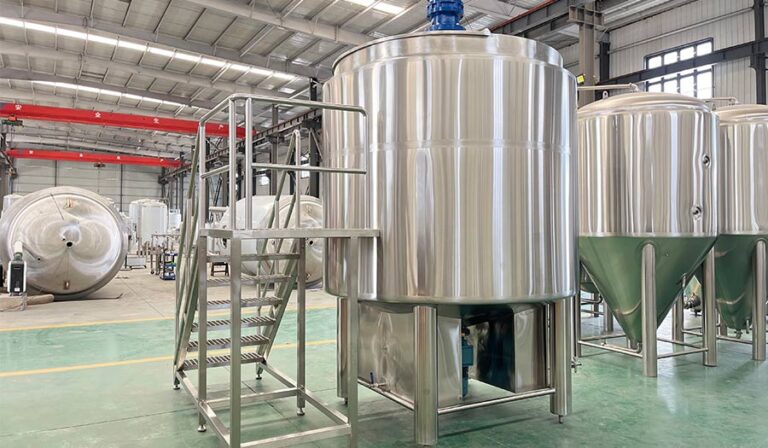
Stainless Steel Storage Tank Purchasing and Maintenance Recommendations
Choosing a Qualified, Professional Manufacturer
When purchasing réservoirs de stockage en acier inoxydable, prioritize manufacturers with food machinery qualifications and extensive industry experience. Reputable manufacturers typically offer products that comply with international certifications such as ISO, CE, and ASME, and maintain comprehensive quality management systems and after-sales service capabilities. Before purchasing, carefully review the manufacturer’s success stories, customer feedback, and sample displays. If necessary, arrange an on-site inspection to verify the equipment’s manufacturing process, welding quality, and internal finish.
Customized Design Based on Process Requirements
Different brewing processes require varying tank capacities, structures, and ancillary functions. During initial planning, it’s recommended to thoroughly discuss production scale, temperature control requirements, space layout, and anticipated expansion plans with the equipment supplier. Select a design that supports modular expansion, ensuring the equipment meets current requirements while also allowing for future upgrades. Special functional requirements (such as yeast recovery, CIP ports, and automatic liquid level monitoring) should also be specified in advance during the order process to avoid later modification costs.
Clearly define after-sales service and warranty terms.
Stainless steel storage tanks are core equipment with long-term use, and the quality of their after-sales service directly impacts production continuity. When purchasing, a clear after-sales service agreement should be signed, stipulating the warranty period, equipment installation and commissioning, training support, spare parts replacement cycle, and response time. High-quality equipment manufacturers typically provide remote technical guidance, regular follow-up visits, and emergency maintenance services, which can significantly reduce the risk of unplanned production stoppages.
Develop a reasonable daily inspection and maintenance plan.
Even the highest-quality stainless steel storage tanks require regular maintenance to extend their service life. It is recommended to establish equipment maintenance records and regularly inspect components such as temperature control systems, gaskets, pressure valves, level gauges, and valves to promptly detect corrosion, leaks, or malfunctions. Critical equipment such as fermentation tanks and CIP tanks should be thoroughly cleaned and sterilized after each batch to prevent contamination caused by residual microorganisms.
Emphasis on accessory compatibility and long-term supply.
Storage tanks may require replacement of accessories such as pressure gauges, thermostats, seals, and valves during use. Therefore, when purchasing, ensure standardized equipment structure and high compatibility of accessories to facilitate future maintenance. Maintain a good working relationship with the manufacturer to ensure rapid access to genuine accessories and technical support throughout the equipment’s lifecycle, avoiding production interruptions or operational disruptions due to incompatible replacement parts.
Résumé
Choosing the right stainless steel storage tank for your brewing process is crucial for ensuring beer quality and production efficiency. The key lies in comprehensively considering multiple factors, including material, capacity, structural design, temperature control, and sealing performance. Scientifically planning equipment configuration, incorporating process requirements and intelligent trends, is crucial. As the brewing industry continues to evolve, intelligent, modular, environmentally friendly, and energy-saving stainless steel storage tanks will become mainstream. Only through careful selection and maintenance can tanks become a solid foundation for your brewing business, supporting the continued production and innovative development of high-quality beer.

